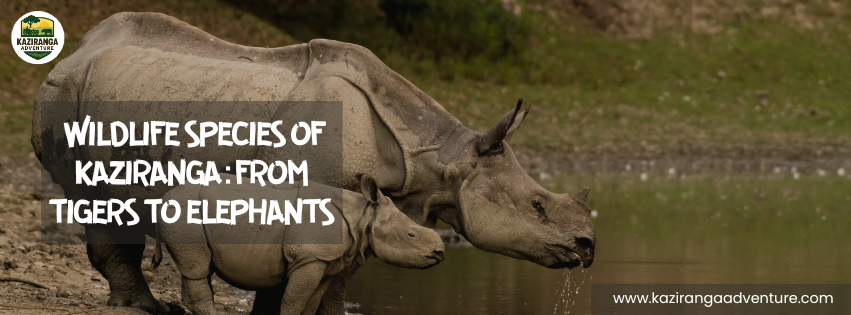Kaziranga National Park, a UNESCO World Heritage Site in Assam, is one of the richest biodiversity hotspots in India. Famous for its One-Horned Rhinoceros, Kaziranga is also home to a wide variety of mammals, birds, reptiles, and aquatic life. From the mighty Royal Bengal Tigers to the gentle Asian Elephants, the park offers a wildlife experience like no other. In this blog, we’ll take you through the fascinating wildlife species of Kaziranga National Park that make it a paradise for nature lovers and wildlife enthusiasts.
The Big Five of Kaziranga
Kaziranga is often compared to Africa’s Big Five safaris. Here, the Big Five include:
One-Horned Rhinoceros – Kaziranga hosts over two-thirds of the world’s population of this rare species.
Royal Bengal Tiger – Declared a Tiger Reserve in 2006, Kaziranga has one of the highest tiger densities in the world.
Asian Elephant – Large herds of elephants roam freely across the park’s grasslands.
Wild Water Buffalo – Kaziranga is home to the largest population of wild water buffalo in the world.
Swamp Deer (Barasingha) – A unique species with distinctive antlers, found in the wetlands of Kaziranga.
Mammals of Kaziranga
Apart from the Big Five, Kaziranga shelters over 35 species of mammals, many of them endangered:
Leopards and Jungle Cats
Sloth Bears
Hoolock Gibbons (India’s only ape species)
Capped Langurs and Rhesus Macaques
Indian Civets and Otters
These species thrive in the park’s unique ecosystems, from grasslands to wetlands and woodlands.
Birdlife in Kaziranga
Kaziranga is recognized as an Important Bird Area (IBA) by BirdLife International. With over 450 bird species, it is a paradise for birdwatchers. Key species include:
Great Indian Hornbill
Pelicans, Storks, and Herons
Fish Eagles and Pallas’s Fish Eagle
Migratory Birds like Bar-headed Geese, Northern Pintails, and Black-necked Storks
The wetlands of Kaziranga provide an ideal habitat for both resident and migratory birds.
Reptiles and Aquatic Life
Kaziranga’s water bodies are home to several reptile species, such as:
Assam Roofed Turtle
King Cobra and Indian Rock Python
Water Monitor Lizards
Ganges River Dolphins in the Brahmaputra waters
These add to the park’s rich wildlife diversity and ecological balance.
Safari Experience to Spot Wildlife
The best way to witness these magnificent species is through a Kaziranga Jeep Safari or an Elephant Safari. Each safari zone – Central, Western, Eastern, and Burapahar – offers unique opportunities to spot different animals and birds.
Central Zone (Kohora): Best for One-Horned Rhinos and Tigers
Western Zone (Bagori): Popular for Elephant Safari and birdwatching
Eastern Zone (Agaratoli): Rich in migratory birds and aquatic species
Burapahar Zone: Best for trekking and spotting primates
Conclusion
Kaziranga National Park is more than just a home for the One-Horned Rhinoceros – it is a living treasure trove of wildlife. From the elusive Royal Bengal Tiger to flocks of migratory birds, the park is a perfect blend of wilderness and natural beauty. A visit to Kaziranga is not just a safari, but a chance to witness the incredible diversity of life that thrives in this pristine landscape.
